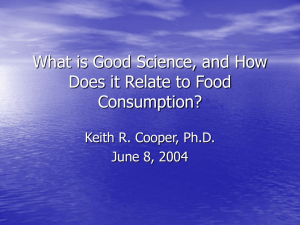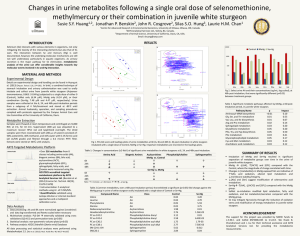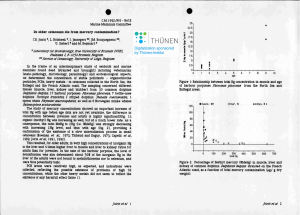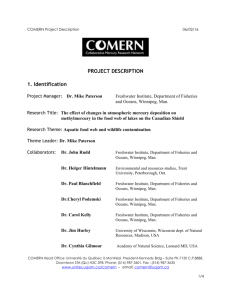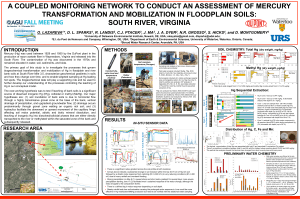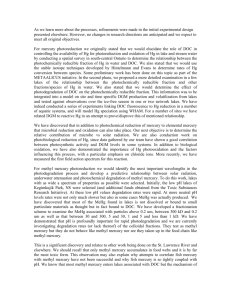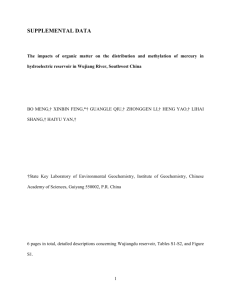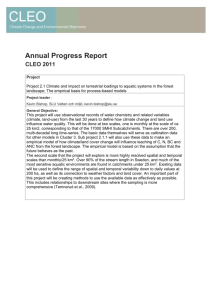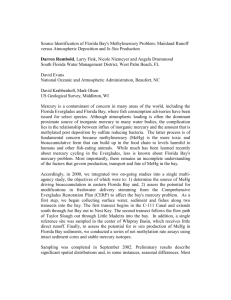Determination of Methyl Mercury in Water and Soil by HPLC-ICP-MS Application Authors
advertisement
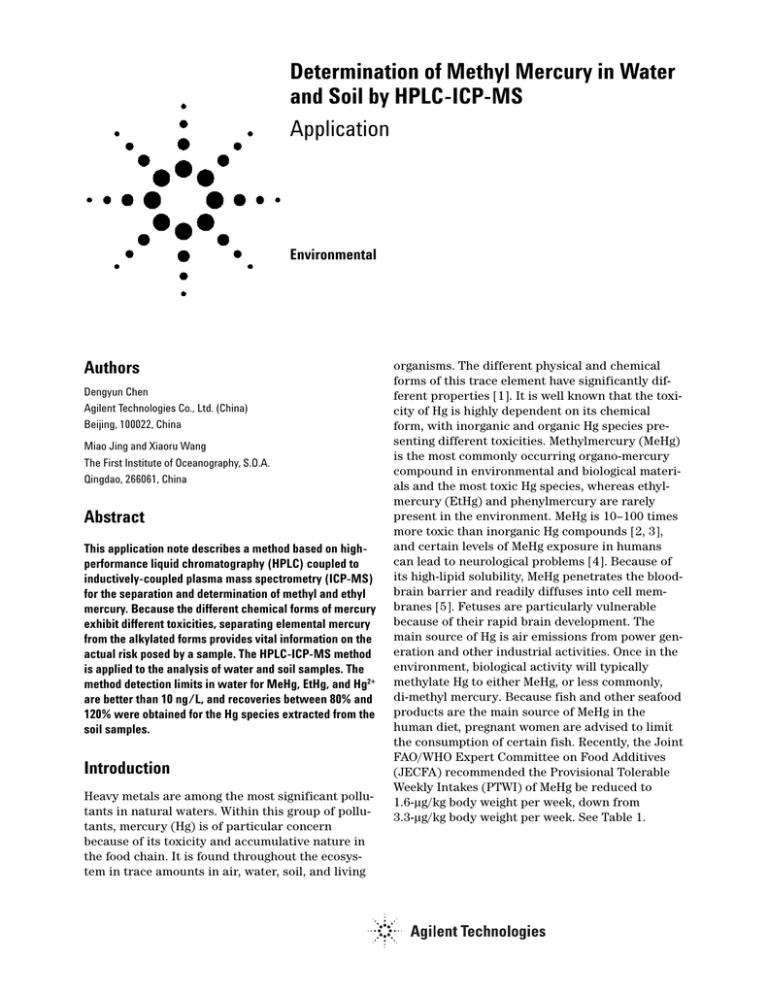
Determination of Methyl Mercury in Water and Soil by HPLC-ICP-MS Application Environmental Authors Dengyun Chen Agilent Technologies Co., Ltd. (China) Beijing, 100022, China Miao Jing and Xiaoru Wang The First Institute of Oceanography, S.O.A. Qingdao, 266061, China Abstract This application note describes a method based on highperformance liquid chromatography (HPLC) coupled to inductively-coupled plasma mass spectrometry (ICP-MS) for the separation and determination of methyl and ethyl mercury. Because the different chemical forms of mercury exhibit different toxicities, separating elemental mercury from the alkylated forms provides vital information on the actual risk posed by a sample. The HPLC-ICP-MS method is applied to the analysis of water and soil samples. The method detection limits in water for MeHg, EtHg, and Hg2+ are better than 10 ng/L, and recoveries between 80% and 120% were obtained for the Hg species extracted from the soil samples. Introduction Heavy metals are among the most significant pollutants in natural waters. Within this group of pollutants, mercury (Hg) is of particular concern because of its toxicity and accumulative nature in the food chain. It is found throughout the ecosystem in trace amounts in air, water, soil, and living organisms. The different physical and chemical forms of this trace element have significantly different properties [1]. It is well known that the toxicity of Hg is highly dependent on its chemical form, with inorganic and organic Hg species presenting different toxicities. Methylmercury (MeHg) is the most commonly occurring organo-mercury compound in environmental and biological materials and the most toxic Hg species, whereas ethylmercury (EtHg) and phenylmercury are rarely present in the environment. MeHg is 10–100 times more toxic than inorganic Hg compounds [2, 3], and certain levels of MeHg exposure in humans can lead to neurological problems [4]. Because of its high-lipid solubility, MeHg penetrates the bloodbrain barrier and readily diffuses into cell membranes [5]. Fetuses are particularly vulnerable because of their rapid brain development. The main source of Hg is air emissions from power generation and other industrial activities. Once in the environment, biological activity will typically methylate Hg to either MeHg, or less commonly, di-methyl mercury. Because fish and other seafood products are the main source of MeHg in the human diet, pregnant women are advised to limit the consumption of certain fish. Recently, the Joint FAO/WHO Expert Committee on Food Additives (JECFA) recommended the Provisional Tolerable Weekly Intakes (PTWI) of MeHg be reduced to 1.6-µg/kg body weight per week, down from 3.3-µg/kg body weight per week. See Table 1. Table 1. Regulated levels (PTWI) of MeHg in Foods Authority Food and Agriculture Organization of the United Nations (FAO) other elemental detector). The low concentration of Hg in natural waters leads to the need for processing very large sample volumes. A preconcentration step is also required because the target reporting limit is often below the sensitivity of the detector used. MeHg (µg/kg body weight) 1.6 World Health Organization (WHO) 1.6 PTWI = Provisional Tolerable Weekly Intakes. In China, the permitted level for MeHg in the “discharge standard of pollutants for municipal wastewater treatment plant of China (GB 18918-2002)” is “undetectable”, that is, below the detection limit (DL) of the recommended method (10 ng/L) [6]. There are several means of determining total Hg in environmental samples, but the simultaneous determination of inorganic and organic Hg is difficult. This is because the typical concentration of MeHg is much lower than for inorganic Hg. The most common methods of Hg speciation are gas chromatography (GC) or HPLC coupled to a Hg-specific detector (fluorescence, photometry, or In China, the recommended method for MeHg measurement (GB/T14204-93) uses GC with an electron capture detector (ECD). Limitations of the method include: • Method detection limit (MDL) of 10 ng/L, despite a complicated enrichment procedure • Method is not element specific • Method suffers from interferences, leading to false positive results or low recoveries The objective of this study was to develop a sensitive and specific MeHg analysis method by combining HPLC with ICP-MS – see Figure 1. Eluent bottles Agilent 7500 ICP-MS Degasser Q-pole ICP Torch Pump Nebulizer/Spray chamber Automated sample tray and injector Turbo pump Column compartment Argon gas controller Agilent 1100 HPLC Figure 1. 2 Agilent 1100 HPLC schematic. Rotary pump Turbo pump Instrumentation Stability and Sensitivity An Agilent 1100 HPLC was interfaced to an Agilent 7500a via the Agilent HPLC-ICP-MS interface. PEEK 20 µL, 100 µL, and 1000 µL sampling loops were selected. The operating parameters of the HPLC and ICP-MS are listed in Table 2a and 2b. To monitor the stability of the instrument, 1.0 µg/L bismuth (Bi) was added to the methanol eluent as an internal standard (ISTD). The 7500a was tuned for maximum sensitivity by optimizing the Bi signal. During the testing period of 10 hours, the RSD of the ISTD was less than 5%. Because the drift was minimal, there was no need for an ISTD correction. No Bi or any other ISTD was used for the actual analyses. Table 2a. Working Parameters of HPLC Column ZORBAX Eclipse XDB-C18, 2.1-mm id × 50 mm, 5 µm Mobile Phase 0.06-mol/L ammonium acetate, 5% v/v methanol, 0.1% 2-mercaptoethanol, pH = 6.8 Flow rate 0.4 mL/min Injection volume 100 µL Table 2b. Working parameters of Agilent 7500a ICP-MS RF power 1550 W Nebulizer PFA concentric 100 µL/min Spray chamber Quartz, Scott double pass, chilled to –5 °C Torch Quartz one piece Fassel type, 2.5-mm injector Sampling depth 4.5 mm Carrier gas flow rate 0.75 L/min Make-up gas flow rate 0.40 L/min HPLC Column For best results, precondition the HPLC column (ZORBAX Eclipse XDB-C18, 2.1 mm id × 50 mm, 5 µm) by pumping HPLC grade methanol at 0.4 mL/min for at least 2 hours, and then condition with eluent (same flow rate) for at least half an hour. Without this conditioning procedure, the inorganic Hg will be affected by contamination in the system leading to poor recovery or peak splitting. Results and Discussion Chromatographic Separation Using Standard Solutions Using the operating conditions stated in Table 2a and Table 2b, a mixed Hg species standard in pure water was injected into the HPLC. The resulting total ion chromatogram (TIC) showed good separation of target species. See Figure 2. MeHg 2.48 32000 28000 Hg Abundance 24000 2+ 3.21 EtHg 6.54 20000 16000 12000 8000 4000 0 0.50 Figure 2. 1.00 1.50 2.00 2.50 3.00 3.50 4.00 4.50 Time (min) 5.00 5.50 6.00 6.50 7.00 7.50 8.00 HPLC-ICP-MS TIC of three mixed Hg species standards in pure water: MeHg 2.48 min, Hg2+ 3.21 min, and EtHg 6.54 min, 100-µL loop. 1.0 ppb each. 3 Table 3. Integration Results of Hg Species Measurement by HPLC-ICP-MS Linearity Efficiency of Detection When the sample was diluted 100 times (10 ng/L for MeHg and EtHg, 8 ng/L for Hg2+), the Hg species could still be measured, as shown in Figure 3. The retention times (RTs) also remained fairly stable. The minor peak with a RT of 1.35 min was caused by column contamination. When the column was cleaned with methanol, the peak disappeared. Because 1.0 µg/L of each Hg species was analyzed, the peak areas for the three species are similar (see Table 3). The slight difference is probably due to the purity of the standards or the error introduced during preparation of the standards. The chromatogram in Figure 3 shows that the MDLs for the Hg species are better than 10 ng/L. If the eluent contamination problem can be solved by using higher purity reagents, sub ng/L MDLs will be achievable. One of the advantages of an HPLC-ICP-MS system is the ability of the argon plasma to decompose and ionize an element, irrespective of the chemical structure of the species. This independence of signal to original structure is called compound independence, and allows a calibration to be constructed based upon Hg molar concentration (Compound Independent Calibration or CIC). Reported results for all species identified will be fairly accurate, even when the compound is unidentified (unknown species). A series of calibration standards was prepared from 10 ng/L to 100 µg/L by diluting the mixed Hg species stock solution (1.0-µg/mL Hg for MeHg and EtHg, 0.8 µg/mL Hg for Hg2+ in pure water). A 20-µL injection loop was used throughout, except for the 10-ng/L data, which was obtained using a 100-µL loop. The peak areas were integrated for the different concentration levels of three mixed Hg species. The linear range of the calibration curves (Table 4 and Figure 4) for Hg speciation by the HPLC-ICP-MS method was at least 4 orders. This range covers expected real sample levels, and so the method is appropriate for direct determination of water samples without the application of complicated preconcentration procedures. RT (min) 2.48 3.21 6.54 Species Hg Conc. (µg/L) Area MeHg Hg2+ EtHg 1.0 0.8 1.0 5.09E+06 3.87E+06 4.91E+06 2800 2600 2400 MeHg 2200 2.35 2000 Abundance 1800 Hg 1.35 2+ EtHg 3.10 1600 6.59 1400 1200 1000 800 600 400 200 0 0.50 Figure 3. 4 1.00 1.50 2.00 2.50 3.00 3.50 4.00 4.50 Time (min) 5.00 5.50 6.00 6.50 7.00 7.50 The HPLC-ICP-MS TIC of 10-ng/L Hg species standards in pure water. (Contaminant 1.35 min, MeHg 2.35 min, Hg2+ 3.10 min, and EtHg 6.59 min, 100-µL loop) 8.0 Log (Conc) vs Log (Intensity) Upper, Me-Hg y = 0.971x + 3.161 R2 = 0.9998 7.5 Log (Intensity, CPS) 7.0 Middle, Et-Hg y = 0.9946x + 3.0042 R2 = 0.9998 6.5 Lower, Hg2+ y = 0.9721x + 2.8192 R2 = 0.9985 6.0 5.5 5.0 4.5 2.0 2.5 3.0 3.5 4.0 4.5 5.0 5.5 Log (Conc, ppt) Figure 4. Table 4. Calibration curves for MeHg, Hg2+, and EtHg. Integration Peak Areas for Different Concentration Hg Species by HPLC-ICP-MS (Hg2+ Concentrations were 80% of the Shown Values) Conc.(ng/L) MeHg Hg2+ EtHg 100000 10000 1000 100 10 1.07E+08 1.06E+07 1.17E+06 1.30E+05 5.86E+04 5.03E+07 4.61E+06 5.72E+05 1.23E+05 3.55E+04 9.83E+07 9.24E+06 9.44E+05 1.02E+05 5.86E+04 Chromatographic Separation of Hg Species in 3% NaCl In order to test the ability of the method for high matrix sample analysis, the stock Hg species solution was diluted into 3% NaCl (w/v in water) to obtain 100 ng/L MeHg, EtHg, and Hg2+. The solution was filtered through a 0.45-µm membrane before analysis. A 20-µL injection loop was used for the measurement. The 202Hg ion chromatogram was overlaid with the corresponding ion chromatogram of the pure water diluted solution at the same concentration, as shown in Figure 5. The peak areas of the Hg species in 3% NaCl were also integrated and the recoveries were between 90% and 110% relative to standards in pure water. This demonstrates that the method is suitable for even high matrix samples such as seawater. 2400 Ion 202.00 (201.70 to 202.70): HG01-S2.D Ion 202.00 (201.70 to 202.70): HG01-A2.D 2200 2000 1800 Abundance 1600 1400 1200 1000 800 600 400 200 0 0.50 Figure 5. 1.00 1.50 2.00 2.50 3.00 3.50 4.00 4.50 5.00 Time (min) 5.50 6.00 6.50 7.00 7.50 8.00 8.50 Overlaid HPLC-ICP-MS ion chromatograms for 100-ng/L Hg species standards in pure water (upper) and in 3% NaCl (w/v, lower) (20-µL loop). 5 Application to Soil Samples When the HPLC-ICP-MS method is applied to solid samples such as tissues, soils, or sediments, sample preparation is necessary. The extraction of Hg species from the solid samples is a crucial step due to the presence of inorganic Hg in environmental samples at low levels. The Hg species, especially MeHg, are easy to lose or transform to other species. To prevent the possible destruction of the MeHg species in a digestion procedure, a number of methods have been reported, including extraction of the compound from samples using dilute hydrochloric acid or chelating agents [7]. Published methods for the extraction of both inorganic and organo-mercury compounds are timeconsuming, labor-intensive, and require large amounts of high-purity solvents or special reagents. In the present work, a simple extraction method based on diluted hydrochloric acid was used. The spike recoveries of the soil samples were between 80% and 120%. Further testing of the method and the MeHg containing reference soil sample are planned. Hg Species Extraction Method 1. Weigh 1.00 g soil sample into a 20-mL plastic centrifuge tube. 3. Add 9.0-mL 7.6% HCl (w/v) and 1.0-mL 10% 2-mercaptoethanol to each tube. Place samples in an ultrasonic bath for 30 minutes to assist the extraction. 4. Centrifuge the samples at 3000 rpm for 5 minutes to partition the particulate matter. 5. Transfer 2.0 mL of the upper (clear) solution in to a 50-mL clean PET bottle. Add 15.0 mL of pure water. 6. Use 10% ammonia solution to adjust the pH of the solution to pH 6.8. 7. Add pure water to the solution until the final solution weight is 20.0 g. 8. Filter the solution through a 0.45-µm membrane before HPLC-ICP-MS measurement. The HPLC-ICP-MS TIC for the soil sample extraction by 7.6% HCl is shown in Figure 6. The soil sample was spiked with 90-ng (as Hg) mixed Hg species standard. The peak height of Hg2+ in the spectrum is higher than the other two peaks because of the presence of inorganic Hg in the soil. Analysis of the unspiked soil sample showed an insignificant level of MeHg and EtHg. The measured results for the spike recovery test are shown in Table 5. 2. Spike 0 to 90 µL of a 100 ng/L mixed Hg species standard solution into the soil samples. Shake to mix. Hg 2+ 3.24 3200 2800 Abundance 2400 MeHg 2.55 2000 EtHg 1600 6.53 1200 800 400 0 0.50 Figure 6. 6 1.00 1.50 2.00 2.50 3.00 3.50 4.00 4.50 Time (min) 5.00 5.50 6.00 6.50 7.00 7.50 8.00 HPLC-ICP-MS TIC for soil sample, S-A-03, extracted by 7.6% HCl, spiked with 0.9-ng (as Hg) mixed Hg species standard. MeHg 2.55 min, Hg2+ 3.24 min and EtHg 6.53 min, 100-µL loop. Table 5. Spike Recoveries of Hg Species in Soil Samples by HPLC-ICP-MS True Value Measured Recovery Sample Hg-Species (pg) value (pg) (%) S-BLK-1 MeHg Hg2+ EtHg NA 61 NA 2 63 + NA 103 NA MeHg Hg2+ EtHg NA 61 NA 9 65 + NA 107 NA MeHg Hg2+ EtHg 90 151 90 85 185 82 95 122 91 S-A-04 MeHg Hg2+ EtHg 90 151 90 80 181 75 89 120 83 S1-1 MeHg Hg2+ EtHg 36 97 36 34 88 28 94 91 77 S1-2 MeHg Hg2+ EtHg 36 97 36 37 105 35 104 108 97 MeHg Hg2+ EtHg 36 97 36 41 98 43 113 101 120 S-BLK-2 S-A-03 S1-3 NA Not applicable + No measurements made The spike recoveries were all between ~80% and 120%, confirming the suitability of the sample preparation procedure for soil sample analysis by HPLC-ICP-MS. References 1. J. O. Nriagu (Ed.), The Biogeochemistry of Mercury in the Environment, Elsevier/NorthHolland Biomedical Press, Amsterdam, 1979. 2. National Academy of Science, An Assessment of Mercury in the Environment, National Research Council, Washington, DC, 1978. 3. R. Hartung, B. D. Dinman (Eds.), Environmental Mercury Contamination, Ann Arbor Science, Ann Arbor, MI, 1972. 4. M. Berlin, 1986. Mercury. In: Friberg, L., Nordberg, G., Vouk, V. (Eds.), Handbook on the Toxicology of Metals. Elsevier, Amsterdam, pp. 387–444. 5. J.S. Felton, E. Kahn, B., Salick, F.C. van Natta, and M.W. Whitehouse, (1972) Heavy metal poisoning: mercury and lead. Ann. Intern. Med. 76, 779–792. 6. Discharge standard of pollutants for municipal wastewater treatment plant of China, GB 18918-2002, 2002. 7. M. Jackie, A. C. Vikki, and H.E.G. Philip., J. Anal. At. Spectrom., (2002), 17, 377–381. For More Information For more information on our products and services, visit our Web site at www.agilent.com/chem. Conclusions HPLC-ICP-MS is appropriate for water samples analysis, even when the matrix in the water sample is high. The MDLs for MeHg, EtHg, and Hg2+ are better than 10 ng/L and meet current regulatory requirements. When the method is applied to soil samples, Hg species extraction by 7.6% HCl is appropriate, with recoveries between 80% and 120%. 7 www.agilent.com/chem Agilent shall not be liable for errors contained herein or for incidental or consequential damages in connection with the furnishing, performance, or use of this material. Information, descriptions, and specifications in this publication are subject to change without notice. © Agilent Technologies, Inc. 2005 Printed in the USA September 6, 2005 5989-3572EN
